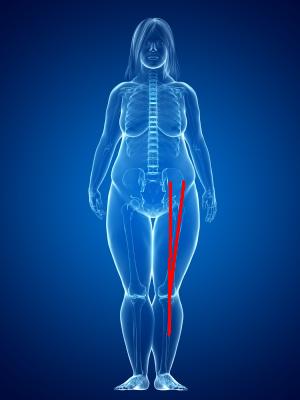Patello-femoral Syndrome
The Q-angle (quadricep angle) is a measurement used by many health care practitioners to assess patello-femoral alignment. It is often mentioned in running magazines and on different websites because of its apparent ability to identify those persons at risk of certain knee injuries. Some of these knee injuries include patellofemoral syndrome, patellofemoral maltracking, chondromalacia patella, patellar tendinosis, patellar tendinitis, osteoarthritis and “runners knee”. But is it a valid measurement tool?
Patellofemoral Syndrome – Diagnosis
The basic premise of the Q-Angle is that a higher angle (such as what might be expected in people with a wider pelvis) would affect the way that the patella (knee-cap) lines up with the lower limb. Some practitioners use it to identify those patients at risk of patellofemoral syndrome. According to the scientific literature though, the Q-Angle is a measurement which over-simplifies knee biomechanics. It only examines a person in one plane of reference (like a two-dimensional object) and does not take into account the complex forces that occur during running, walking and jumping. Numerous publications in very reputable journals have scrutinized its ability to accurately identify those people at risk of knee pain and patellofemoral syndrome.
Patellofemoral Syndrome – Treatment
The treatment for patellofemoral syndrome varies, depending on the specific nuances of each individual case. At our physiotherapy and chiropractic clinic in Burlington, we try to use good science to guide our decisions and our advice. Commonly, the treatment for patellofemoral syndrome involves soft tissue therapy and strengthening exercises. Obviously, the best course of action is to give our clinic a call and speak with one of our practitioners. In the meantime you may want to take a look at our services page; specifically our active release technique and our graston page. Curious about who will be helping you with your injury? Check out our practitioners page! 905.220.7858 info@burlingtonsportstherapy.com
References
Duffey MJ, Martin DF, Cannon DW et al. Etiologic factors associated with anterior knee pain in distance runners. Med Sci Sports Exerc. 2000; 32: 1825-1832.
Nguyen AD, Boling MC, Levine B, Shultz SJ. Relationships between lower extremity alignment and the quadriceps angle. Clinical Journal of Sports Medicine. 2009; 19(3): 201-206.
Thomee R, Renstrom P, Karlsson J et al. Patellofemoral pain syndrome in young women. A clinical analysis of alignment, pain parameters, common symptoms and functional activity level. Scand J Med Sci Sports. 1995; 5: 237-244.
Witvrouw E, Lysens R, Bellemans J et al. Intrinsic risk factors for the development of anterior knee pain in an athletic population. A two-year prospective study. American Journal of Sports Medicine 2000; 28: 480-489.
Disclaimer https://burlingtonsportstherapy.com/blog/disclaimer/










